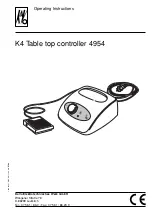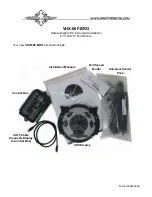
RTC
®
5 PC Interface Board
Rev. 1.9 e
7 Basic Functions for Scan Head and Laser Control
147
innovators for industry
Vector-Defined Laser Control
Vector-defined laser control makes possible to
linearly vary a signal parameter along a mark or jump
vector.
To initialize vector-defined laser control,
must be called to define the
signal parameter to be varied (via the
Ctrl
parameter) and to set the initial value of this signal
parameter (
Value
parameter).
For subsequent para-mark and para-jump commands
(i.e. parameterized mark and jump commands), the
RTC
®
5 will then linearly vary the selected signal
parameter along with the varying of coordinates. The
start value for the first para command is the initial
value defined with
Value
parameter)
(1)
. The signal parameter will be microvec-
torized like a normal coordinate and linearly varied
until the defined end value (defined by the
P
parameter). The end value is the start value for a
subsequent para command.
The following para-mark and para-jump commands
are available:
•
,
•
•
•
If the 3D option is enabled, 3D para commands can
also be executed:
•
•
•
•
,
The para command
can
be used for marking points.
Notes
• If a para command’s desired start value differs
from the previous para-command’s end value,
then the corresponding signal-parameter change
between both commands can be achieved via
with a jump “to the same place”
or via a renewed call of
with
a new initial parameter value.
If, between two para-commands, a list command
(e.g.
or
) is called, then the signal
parameter will also temporarily change. Even so,
the start value for the second para-command will
still be the end value of the first para-command.
Control commands such as
or commands that explicitly change the
Ctrl
parameter’s set value (e.g.
) should be avoided during
processing of a list of para-commands.
• Vector-defined laser control has
direct
effects
only with para-commands (normal mark and
jump commands do not change the currently set
value of the
Ctrl
parameter), but has indirect
effects under some circumstances with normal
mark and arc commands or timed mark
commands (also see
If, in addition to vector-defined laser control
(
Ctrl
= 1…6), a position- and/or speed-
dependent or encoder-speed-dependent laser
control of the same signal parameter has simulta-
neously been activated, then the current signal
parameter value for vector-defined laser control
becomes the basis for the 100% value of position-
and/or speed-dependent or encoder-speed-
dependent laser control:
– During initialization of vector-defined laser con-
, the 100% value
will be set to the initial value defined by
(
Value
parameter).
– During execution of subsequent para-com-
mands, the 100% value is continuously varied
in accordance with the current signal parame-
ter value.
– During deactivation of vector-defined laser con-
(parameter
Ctrl=0
), the 100% value will be reset to the ini-
tialized value (
Value
parameter of
).
• For para commands, a nonlinearity curve loaded
via
only effects signal
parameters selected via
position- and/or speed-dependent or encoder-
speed-dependent laser control has been activated
for the same signal parameter (
Ctrl
= 1…6).
• During execution of para commands, the
Sky writing mode (see
) is
not
taken into
account (but also not deactivated).
(1) With
Ctrl
= 7 (focus shift), a hard jump of the Z coordinate
to the initial value might occur.
















































